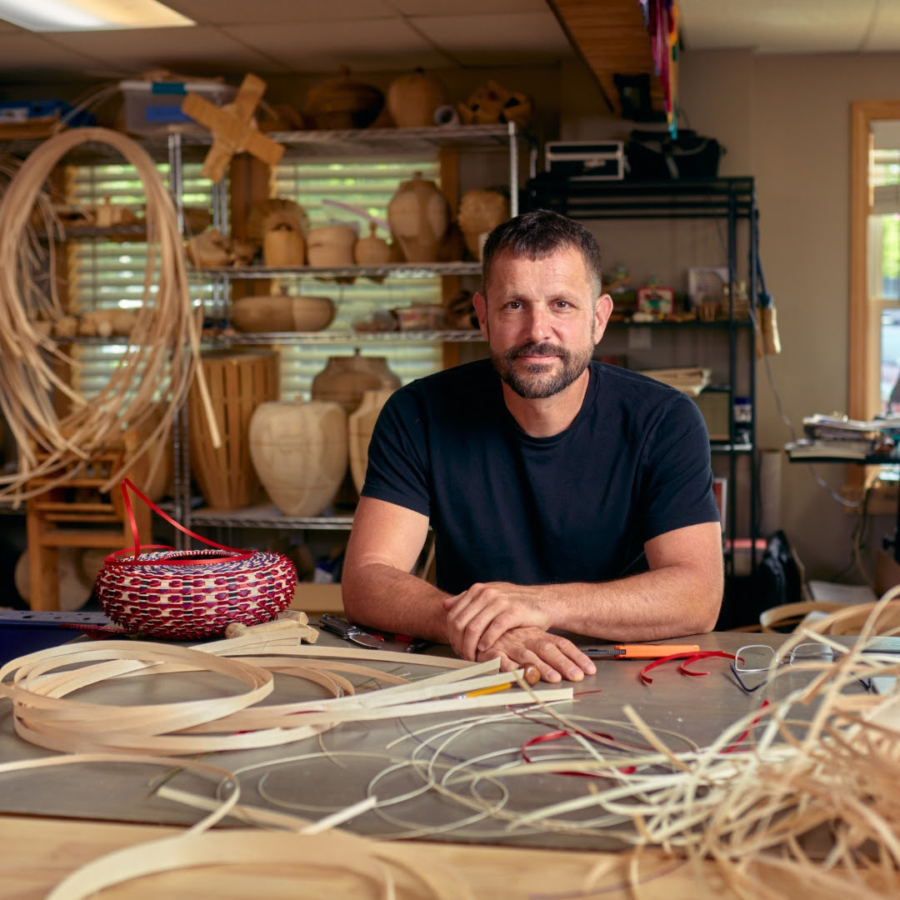March-April 2016
Download as PDF
View on Art in Print
Los Angeles-based artist Mungo Thomson has recently completed an ambitious new project at Highpoint Editions in Minneapolis. Thomson’s work is deeply rooted in the legacy of conceptual art—particularly the West Coast iteration seen in the work of such pioneering artists as John Baldessari and Edward Ruscha—and often has a strong connection between language and image. His project at Highpoint follows the artist’s mirrored paintings from 2012, which replicate the format and typography of Time magazine on their surface while also reflecting the viewer. The Highpoint prints are based on Time-Life books, a popular series of general interest volumes published in the 1960s and ’70s. One print reproduces the colorful spines of the 14-volume series Human Behavior (published in 1976); the other replicates the cover of The Forest, a volume in the Time-Life Nature Library (published in 1961). Nearly four feet high, both prints render their subjects monumental and imposing. Siri Engberg discussed the project with Thomson:
Siri Engberg: What drew you to the TimeLife book series as subject matter?
Mungo Thomson: I grew up in a Northern California college town in the 1970s and ’80s, surrounded by academicism and suburban American middle-class normalcy, and also by the iconography of all the fringe mysticisms and activisms that flourished in that place and time— everything from Bob Dylan and Carl Sagan to National Geographic to whale song records and wind chimes. Time-Life books exist within that rubric for me. My dad had rows of them on the shelf, and they were acquired—collected—one volume per month, by mail-order subscription. I think they typify a certain late 20th-century American zeitgeist of intellectual curiosity and even class mobility: they offered an aspirational bridge between the layman and the specialist. One of their tag lines was “Become an Instant Expert”: they offered a fantasy of a common cultural narrative and a knowable universe.
This notion has now been completely fractured by the Internet, but I’m interested in the way Time-Life books, covering such a vast range of subjects, suggested a kind of proto-Internet themselves. I’ve been collecting Time-Life books for a few years and working on a stop-motion film project and working on a stop-motion film project about them. When Highpoint asked me to do a print, I was in the process of considering the material for the film.
SE: What was your thinking behind the sequencing of the book spines in the first print? I’m interested in the freeform narrative of these—how the titles evolve from the universal to the dark, and then how The Forest suggests something far more ambiguous.
MT: The flat wall of titles—Language, How We Learn, The Family, Status and Conformity, Stress, Crime, The Individual, etc.— are essentially an itemized list of how we organize civilization, which contrasts with a picture of wilderness. The gold vertical titles might suggest that human behavior, or our understanding of it, can be a prison, or a barricade against nature. So it’s important that the book spines are very formal and flat—a barrier—and that The Forest be open and enterable, like a door or window. This suggested a diptych to me in terms of scale and content. Pairing these two images—one neat and closed and one messy and open—pairs the content as well.
SE: The oversized scale of these very much impacts one’s experience of the piece. How did you determine the size of the images?
MT: The scale is as large as we could go given the screens and paper standards available to us; I wanted something big and immersive, so you are able to feel you can step into that forest. I am also trying to encourage an anthropological
reading of them—to see them as frames through which we see.
SE: How was the process of collaborating with a master printer different from or similar to the way you have approached other projects?
MT: Many of the decisions I made about the finishing and the scale have to do with the properties and standards in the Highpoint shop. Just as some of these Time-Life books have little bells and whistles in their printing, with tipped-in photographs and foil text on top of cloth bindings and varnish, Highpoint offered some of those same options for our prints. So I liked that symmetry. I think there is probably even some overlap between the heyday of fine art printmaking and Time-Life books. Working with a master printer was different for me because I spend so much more time in the realm of more digital and on-demand production modes, but making a print of this complexity takes a different kind of time. The process is absolutely painstaking, but [Master Printer] Cole [Rogers] is very thorough—he made sure I saw the best possible iteration of that idea before letting me give up on it.



